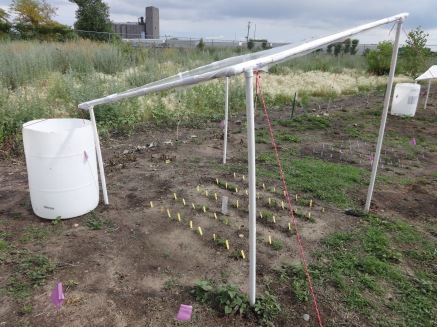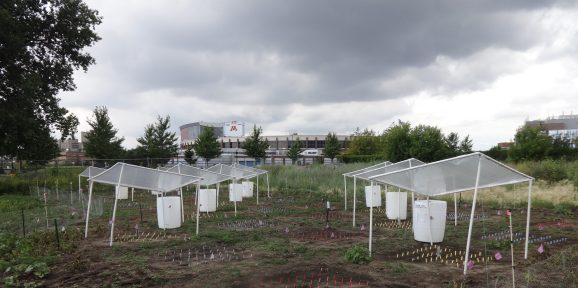The precipitation experiment is in full swing! Woohoo! So is my latitudinal reciprocal transplant experiment…but more on that another day when I finish field work early.
The experiment was planted at the beginning of June (yes…this is a late blog post), with 30 plots total. There are 10 control plots, 10 addition plots, and 10 reduction plots. Each plot has seeds from 26 populations I collected from Minnesota to Louisiana in 2014 and 2015. Depending on which is your favourite BIOCLIM variable to look at, these populations span a gradient of precipitation, with populations from Minnesota experiencing drier climates than those from Louisiana.

Annual precipitation, with lighter green corresponding to lower rainfall. Image taken from BONAP climate maps.
Over of the course of the growing season (July-Oct), I am reducing precipitation by 30% and increasing precipitation by 30% for the reduction and addition plots, respectively. To do this, I’m employing event based rain exclosures, which basically means I’ve become a storm chaser!
For certain rain events, I am covering the reduction plots with rainout shelters I constructed out of PVC pipes and overwintering plastic. I made these structures with the help of another graduate student at the University of Minnesota, Anna Peschel, who is also conducting a precipitation experiment at the same field site, focusing on the partridge pea, Chamaecrista fasciculata (a much cuter plant than ragweed).
For the addition plots, on the days we deploy the rainout shelters, I am recording the amount of rain that fell at the field site with rain gauges, then adding that volume of water to the addition plots with watering cans.
We started the precipitation treatments at the beginning of July, which is very exciting! The tricky part is if the storm is going to be too severe (crazy wind, hail, etc), we can’t put them out because the structures will be destroyed. Basically we are hoping for lots of mild rain storms over the course of the season! Fingers crossed.





Sounds like a cool experiment! Are you measuring plant growth, or some other metric of fitness?
LikeLike
Thanks! I’m going to score female and male flowering time each week, and measuring height at regular intervals as a metric of growth. I’ll also be counting fruit at the end of the season.
LikeLike
Pingback: Field season is almost over…updates soon! | Amanda J. Gorton
Pingback: Amanda starts her rainfall manipulation experiment – Moeller Lab